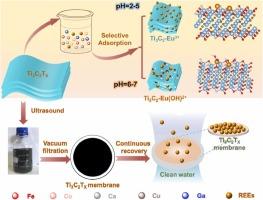Functionalized 2D Multilayered MXene for Selective and Continuous Recovery of Rare Earth Elements from Real Wastewater Matrix
IF 12.2
1区 环境科学与生态学
Q1 ENGINEERING, ENVIRONMENTAL
引用次数: 0
Abstract
Rare earth elements (REEs) are the “fuel” for high-tech industry, yet their selective recovery from complex waste matrices is challenging. Herein, we designed a 2D multilayered MXene Ti3C2Tx adsorbent for selective extraction of REEs in a broad pH range. By establishing strong Lewis acid-base interactions, extraction capacities of Ti3C2Tx to Eu(III) and Ho(III) reached 892.8 and 649.2 mg/g, respectively, even at pH 2.0. Following the Valence Matching Principle, the Ti3C2Tx adsorbent also demonstrated high selectivity for recovery of various REEs from real REEs processing wastewater and actual sludge from magnet manufacturing industry. To demonstrate the practical feasibility, a layer-stacked membrane of Ti3C2Tx supported on polyethersulfone substrate was fabricated for continuous recovery of REEs and exhibited excellent removal of Eu(III) (99.1% at pH 5.0), showcasing its potential for large-scale applications. DFT calculations and material characterization demonstrated that chemisorption between Lewis acid (REEs cations) and Lewis base (F and O) sites is the main adsorption process involved in the uptake of Eu(III) and Ho(III). Finally, both the Ti3C2Tx adsorbent and membrane were successfully regenerated and reused via simple acid wash. Overall, the results demonstrate the Ti3C2Tx-based recovery as a promising path for sustainable harvesting of REEs.

功能化二维多层MXene从实际废水基质中选择性连续回收稀土元素
稀土元素(ree)是高科技产业的“燃料”,但从复杂的废物基质中选择性回收它们具有挑战性。在此,我们设计了一种二维多层MXene Ti3C2Tx吸附剂,用于在宽pH范围内选择性提取稀土。通过建立强的Lewis酸碱相互作用,在pH为2.0时,Ti3C2Tx对Eu(III)和Ho(III)的萃取量分别达到892.8和649.2 mg/g。根据价态匹配原理,Ti3C2Tx吸附剂对实际稀土加工废水和磁铁制造业实际污泥中各种稀土元素的回收也表现出较高的选择性。为了证明其实际可行性,制备了一种基于聚醚砜衬底的Ti3C2Tx层叠膜,用于连续回收稀土,在pH 5.0下对Eu(III)的去除率达到99.1%,显示了其大规模应用的潜力。DFT计算和材料表征表明,Lewis酸(REEs阳离子)和Lewis碱(F和O)位点之间的化学吸附是Eu(III)和Ho(III)吸附的主要吸附过程。最后,Ti3C2Tx吸附剂和膜通过简单的酸洗成功再生并重复使用。总体而言,结果表明基于ti3c2tx的回收是可持续收获稀土的有希望的途径。
本文章由计算机程序翻译,如有差异,请以英文原文为准。
求助全文
约1分钟内获得全文
求助全文
来源期刊

Journal of Hazardous Materials
工程技术-工程:环境
CiteScore
25.40
自引率
5.90%
发文量
3059
审稿时长
58 days
期刊介绍:
The Journal of Hazardous Materials serves as a global platform for promoting cutting-edge research in the field of Environmental Science and Engineering. Our publication features a wide range of articles, including full-length research papers, review articles, and perspectives, with the aim of enhancing our understanding of the dangers and risks associated with various materials concerning public health and the environment. It is important to note that the term "environmental contaminants" refers specifically to substances that pose hazardous effects through contamination, while excluding those that do not have such impacts on the environment or human health. Moreover, we emphasize the distinction between wastes and hazardous materials in order to provide further clarity on the scope of the journal. We have a keen interest in exploring specific compounds and microbial agents that have adverse effects on the environment.
 求助内容:
求助内容: 应助结果提醒方式:
应助结果提醒方式:


